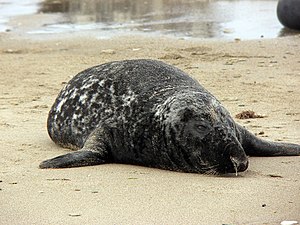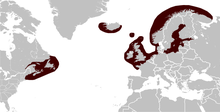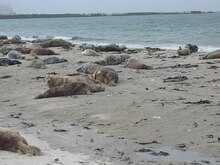Gray seal
| Gray seal | ||||||||||||
|---|---|---|---|---|---|---|---|---|---|---|---|---|

Gray seal |
||||||||||||
| Systematics | ||||||||||||
|
||||||||||||
| Scientific name of the genus | ||||||||||||
| Halichoerus | ||||||||||||
| Nilsson , 1820 | ||||||||||||
| Scientific name of the species | ||||||||||||
| Halichoerus grypus | ||||||||||||
| ( Fabricius , 1791) |
The gray seal ( Halichoerus grypus ) is adjacent to the seal , the second common at German coastal seal species , and next to it the largest free-living occurring in Germany predator (up to 300 kg in weight and 2.5 meters tall). The name is derived from the conical teeth and head shape of the seal.
features
The gray seal differs from the common seal in that it is much more massive. Seals also have a rounded head, while gray seals have a rather pointed head. The males are lightly spotted on a dark gray background, while the females are dark gray spotted on a silver gray background. Young animals are born with white embryonic hair ( lanugo ), which is replaced by normal fur after about five weeks.
With a size of 230 centimeters and a weight of 220 kilograms, a male gray seal is significantly larger than a harbor seal, but also than a female gray seal (180 cm, 150 kg). Males also have larger noses than females. The sexual dimorphism is only so pronounced in a few dog seals.
distribution
Gray seals occur in three separate populations:
- The East Atlantic gray seals live mainly on the coasts of Great Britain , Ireland , Northern France, Iceland and the Faroe Islands , rarely in the North Sea or Baltic Sea.
- The West Atlantic gray seals live on the Canadian coasts of Labrador , New Brunswick, and Nova Scotia .
- The Baltic gray seal ( H. g. Balticus ) is considered an independent subspecies. It used to be widespread throughout the Baltic Sea , but has been pushed back to the northernmost parts (coasts of Sweden , Finland , Latvia and Estonia ) through intensive hunting . In the meantime, however, migratory gray seals - mostly younger ones - come to the coasts of Poland and Mecklenburg-Western Pomerania and are regular guests in the Western Pomerania Lagoon Area National Park and the Greifswalder Bodden , where a population of at least 290 animals has been determined.
Gray seals in the Wadden Sea
In the Wadden Sea there are several colonies with youngsters: one on the West Frisian island of Terschelling , on the Kachelotplate west of Juist , and another on Jungnamensand , a sandbank west of the North Frisian island of Amrum . Since 2001 the gray seal has been rearing its young on the dune near Helgoland ; a North Sea colony seems to be establishing itself here as well. Outside of the breeding season, the seals in these colonies stay in various places within the North Sea and then mix with harbor seals. In winter, for example, you can find them in the East Frisian Wadden Sea.
Compared to harbor seals, gray seals are real rarities in the Wadden Sea. From archaeological finds we know that in the Middle Ages gray seals and harbor seals were equally common, perhaps even an overweight in favor of the gray seal. However, the gray seal reacted far more sensitively than the harbor seal to the hunting pressure exerted on the seals by humans, so that it almost completely disappeared from the Wadden Sea.
It was not until the second half of the 20th century that the gray seals, who had survived on the rocky and inaccessible shores of the British Isles, gradually returned. Even today, according to zoologists, the gray seals in the Wadden Sea could not survive without constant supplies from Great Britain. The birth of young gray seals is still an extremely rare occurrence today. In order to protect the offspring from curious mudflat hikers , the employees of the Wadden Sea National Parks try to guard all known young animals or to cordon off their berths if possible.
Gray seals in the Baltic Sea
The fact that until a few years ago there were no more gray seals in the western Baltic Sea, apart from a few stray individual animals, is due to an extinction campaign in the late 19th and early 20th centuries. Because the fishermen of the coasts assured that their livelihoods were threatened because of the seals, a premium was paid for every seal killed. By 1930 the harbor seal and gray seal were completely wiped out in the western Baltic Sea.
From 1998 to 2000, the Federal Agency for Nature Conservation had an analysis carried out as to whether the gray seal could be reintroduced into the German Baltic Sea coast. The gray seals are not expected to return on their own because of the insufficient population pressure in their current home in the eastern Baltic Sea. Numerous stretches of coastline were examined and several potential berths identified, for example the Wittow peninsula (North Rügen ) or the Greifswalder Oie . While the fishermen are still reluctant to resettle, the majority of the local population looks forward to the project benevolently. In October 2012 , the local council of Altenkirchen agreed to a resettlement and was already speculating on future prominence as the gray seal community Altenkirchen . In addition, there were plans to raise the former island of Stubber , which can only be seen at low tide due to the removal of building materials for road construction in Greifswald , by applying sand again above the water level. Several gray seals have lived on the existing sandbank since the mid-2000s. Nevertheless, a resettlement project has so far failed due to resistance from the fishermen. In 2019 more than 38,000 gray seals were counted in the Baltic Sea.
Way of life

Outside the breeding season, juvenile gray seals in particular migrate widely, but apparently keep returning to the same breeding sites. On their dives of up to 20 minutes, gray seals reach depths of 140 meters and hunt for fish. Each adult gray seal needs around ten kilograms of fish per day. The fish caught include salmon , cod , herring , mackerel and plaice . However, it has also been observed that gray seals can attack and eat porpoises , juvenile seals and juveniles of their own species.
During the breeding season, gray seals gather to form small colonies on the coasts. These consist of an average of six females and one male. In larger colonies there are several males, each trying to hold a harem together. The successful males defend up to ten females and their young and mate with them as soon as the young are weaned. This happens when the cubs are around four weeks old.
The breeding season varies with the area of distribution. In the East Atlantic it is between September and December, in the West Atlantic in January and February. The Baltic gray seals shed in February and March. The gestation period is eleven and a half months. Sexual maturity is reached at four to five years of age, but males are not strong enough to guard a group of females before they are eight years old. Life expectancy is usually twenty years, in exceptional cases over 45 years.
Hazard and protection
Gray seals were of little commercial interest to seal hunters; but many were killed by fishermen who saw them as competition. They are now protected in most countries; the populations have grown to around 100,000 gray seals in the eastern Atlantic. 40 percent of the world's gray seal population lives on the coasts of Great Britain .
The world population of gray seals is indicated by the International Union for Conservation of Nature IUCN in its Red List as “ Least Concern ” . The Federal Republic of Germany places this seal species in the national Red List in Category 2 and thus assesses it as very endangered. The state of Schleswig-Holstein presents them as endangered in their Red Lists; They see Mecklenburg-Western Pomerania and Lower Saxony as endangered migratory animals in their region.
The gray seal is placed under protection by the Bern Convention of the Council of Europe , which puts it in Appendix III and thus marks it as a strictly protected wild animal that may only be used in exceptional cases.
The European Union adopts this diction via the Fauna-Flora-Habitat Directive No. 92/43 / EEC or the new version No. 2006/105 / EC, Appendix V. In addition, the gray seal, like all species of the genus Phocidae , is listed in Appendix II posed, whereby the establishment of protected areas is required.
In the Federal Republic of Germany, the seal species is designated as particularly protected in the Federal Nature Conservation Act.
The development of the Baltic gray seal subspecies is of particular concern. At the end of the 1980s, the population had fallen to 1,500 animals. In addition to the persecution by humans, the cause here was the introduction of poisons such as DDT . In the 1990s, the population in the Baltic Sea began to increase again thanks to strict protective measures and a lower level of pollution. In 2000 there were again around 15,000 gray seals in the northern and eastern areas of the Baltic Sea. Due to an average population increase of 8% per year, the 2005 population was estimated at 22,000 specimens. Protection zones have been set up in several places where visitors are absolutely prohibited. In Sweden and Finland there are persistent problems with fishermen whose traps are damaged by gray seals. The annual losses in Sweden alone are estimated at 50 million crowns . Therefore, the nature conservation authorities of these countries allowed a limited gray seal hunt of around 200 animals per year.
In addition to the protection provisions of the nominate species, the subspecies of the Baltic gray seal is placed under protection by listing in Appendix II of the Bonn Convention CMS, the Convention for the Conservation of Migratory Wildlife Species. It is stated here that international cooperation is required to preserve the species.
literature
- Ronald M. Nowak: Walker's Mammals of the World . 6th edition. Johns Hopkins University Press, Baltimore 1999, ISBN 0-8018-5789-9 (English).
- Jochen Schwarz among others: Resettlement of the Baltic gray seal (Halichoerus grypus balticus) on the German Baltic coast. Federal Agency for Nature Conservation, Bonn 2003, ISBN 3-7843-3726-0 .
Individual evidence
- ↑ Gray seals . In: Wadden Sea National Park . July 26, 2010 ( nationalpark-wattenmeer.de [accessed August 25, 2017]).
- ↑ Gray seal. Hanover Zoo, accessed on August 25, 2017 .
- ↑ Gray seals. NABU, accessed August 25, 2017 .
- ↑ More gray seals than ever in the Baltic Sea. In: Kiel News. Retrieved April 25, 2018 .
- ↑ The number of gray seals in the Wadden Sea continued to rise . In: Passauer Neue Presse . ( pnp.de [accessed on July 9, 2018]).
- ↑ http://www.nlwkn.niedersachsen.de/andere_themen/kachelotplate/45350.html
- ↑ Mecklenburg-Western Pomerania: Seals are returning to the Baltic Sea. In: Spiegel Online. May 22, 2013, accessed November 2, 2014 .
- ↑ Birgit Sander / dpa: Economy vs. Animal welfare: gray seals are taking back the Baltic Sea - to the chagrin of the fishermen. In: svz, de . December 29, 2019, accessed December 30, 2019 .
- ↑ Mardik F. Leopold, Lineke Begeman, Judith van DL Bleijswijk, Lonneke L. IJsseldijk, Harry J. Witte, Andrea Grone: Exposing the gray seal as a major predator of harbor porpoises . In: Proceedings of the Royal Society Series B . tape 282 , no. 1798 , January 7, 2015, doi : 10.1098 / rspb.2014.2429 (English, open access).
- ↑ Abbo van Neer, Lasse Fast Jensen, Ursula Siebert: Gray seal (Halichoerus grypus) predation on harbor seals (Phoca vitulina) on the island of Helgoland, Germany . In: Journal of Sea Research . tape 97 , 2015, p. 1–4 , doi : 10.1016 / j.seares.2014.11.006 (English).
- ↑ Abbo van Neer, Stephanie Gross, Tina Kesselring, Peter Wohlsein, Eva Leitzen: Behavioral and pathological insights into a case of active cannibalism by a gray seal (Halichoerus grypus) on Helgoland, Germany . In: Journal of Sea Research . tape 148-149 , June 1, 2019, ISSN 1385-1101 , pp. 12–16 , doi : 10.1016 / j.seares.2019.03.004 (English, sciencedirect.com [accessed on September 20, 2019]).
- ^ Research into seal deaths. Scottish Government Press Release, 2015 ( Memento dated February 16, 2015 on the Internet Archive )
- ↑ Red List of Endangered Animals in Germany. (PDF 429.39 kB) (No longer available online.) In: Binot & al. 1998 register. German Federal Agency for Nature Conservation, archived from the original on March 1, 2016 ; Retrieved January 18, 2010 . Info: The archive link was inserted automatically and has not yet been checked. Please check the original and archive link according to the instructions and then remove this notice.
- ↑ Online query of the gray seal in the Red List of Endangered Animals in Germany and its federal states. science4you, accessed February 4, 2010 .
- ↑ Bern Convention. Council of Europe, accessed January 18, 2010 (Appendix III).
- ↑ Directive 92/43 / EEC (Fauna-Flora-Habitat Directive) in the consolidated version of January 1, 2007 , accessed on January 18, 2010
- ↑ Council Directive 2006/105 / EC of November 20, 2006 for the adaptation of Directives 73/239 / EEC, 74/557 / EEC and 2002/83 / EC in the field of the environment on the occasion of the accession of Bulgaria and Romania , accessed on September 15 2019
- ↑ WISIA search service of endangered species. In: WISIA Online. German Federal Agency for Nature Conservation, accessed on January 18, 2010 .
- ^ Population of the gray seal, Swedish nature conservation authority Naturvårdsverket (Swedish) ( Memento from August 3, 2008 in the Internet Archive ).
- ↑ B. Jensen: Nordens däggdjur. 2nd edition, Prisma Verlag, 2004, ISBN 91-518-4432-X .
- ↑ Limited hunt for gray seals ( page no longer available , search in web archives ) Info: The link was automatically marked as defective. Please check the link according to the instructions and then remove this notice. , Swedish Nature Conservation Agency, visited May 1st, 2009.
- ↑ CMS Appendices I and II. (PDF; 88.75 kB) UNEP-WCMC, March 2009, accessed on January 18, 2010 (search for Halichoerus grypus).
Web links
- Gray seal photos from the natural habitat of the North Sea
- Halichoerus grypus in the endangered Red List species the IUCN 2009. Posted by: Thomspon, D. & Harkonen, T. (IUCN SSC Pinniped Specialist Group), 2008. Retrieved on January 18 of 2010.
- Gray seal camera on the Estonian coast









